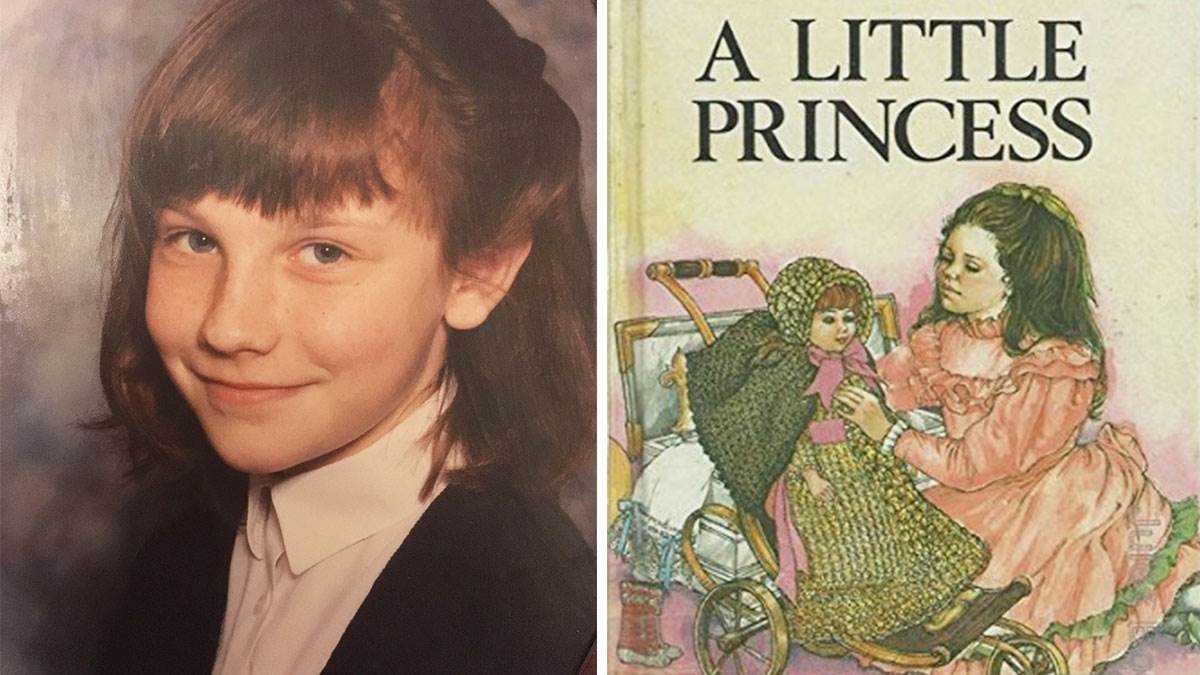The Book That Made Me: Michelle Harrison
Published on: 15 January 2020 Author: Michelle Harrison
What's the childhood book that made you who you are today?
Writer Michelle Harrison struggled to choose just one life-changing book, but, in the end, settled on the one that made her daydream the most about her own happy ending...

Left: writer Michelle Harrison; right: from the front cover of A Little Princess by Frances Hodgson Burnett
I can’t be the only author who feels a sense of panic at being asked to choose a single book that shaped my life. Just one? But there are so many! For instance, Gobbolino the Witch’s Cat, which I listened to on audiobook over and over, and is the reason I still love black cats today.
Or My Big Book of Fairy Tales, an enormous, heavy thing with hundreds of stories which I read until it fell into two pieces. After that, I read it even more (it was easier to hold).
Then there’s The Witches by Roald Dahl. I vividly recall the thrill of wanting to turn the page, but being too afraid to. It was the first time I realised I enjoyed being scared by stories – something I now try to pass on to my readers.
My sisters made me a bookworm
I credit my sisters for my love of books. They were aged 14 and 17 when I came along, so I really was the "baby" of the family and I revelled in the attention. Most of all, I loved the stories. My sisters read to me frequently and they’d also invent their own tales, even illustrating them – quite often re-doing them if I wasn’t satisfied!
I grew up in a council house in Grays, Essex, in the most working-class family you could imagine. My mum was a cleaner and barmaid, my dad a bricklayer. We weren’t poor, but we weren’t well off, either. We had a cupboard full of my sisters’ old, yellowed books, most of them by Enid Blyton.
Though her work is criticised today, it would be a lie to say any other author impacted my reading like she did. I remember my sister refusing to read yet another chapter (I think it was Five Go to Smuggler’s Top) to me one day, and so I carried on myself. That was it – I was a bookworm. I went on to read the Famous Five series countless times, as well as Malory Towers, St Clare’s, and pretty much everything in the house.
Lead character with imagination and kindness
However, the book I’ve chosen is A Little Princess by Frances Hodgson Burnett. I was introduced to it thanks to the 1986 TV series starring Maureen Lipman as the awful Miss Minchin. I was immediately drawn to wealthy Sara Crewe, her beautiful clothes and her beloved doll, Emily. I was thrilled when my mum surprised me by buying a Ladybird edition of the story. After my sisters’ dog-eared hand-me-downs, a new book was a little piece of treasure that was all mine: crisp and perfect, never owned or read by anyone else.
It’s fair to say Sara Crewe was the first character I properly looked up to. Admittedly, I admired her luxurious dresses and possessions, just as much as all the girls at Miss Minchin’s school. However it was Sara’s imagination and kindness that inspired me most. She loved stories, just like me! She got ‘snappish’ when her reading was interrupted – something I’ve always been guilty of. When my sisters visited Holland, they returned with a china doll who instantly became my very own "Emily".
And Miss Minchin – what a villain. Very early on, Sara senses Miss Minchin’s grudge against her. Looking back, perhaps this helped cement my certainty that one of my teachers disliked me – though I wouldn’t have made this connection at the time. I wasn’t a naughty child, and I never knew why or felt it with any other teacher. It’s a horrible, confusing thing for a child when an adult doesn’t like them, but they always know. And I simply knew in my bones it was true.
Imagining myself in a story
When Sara is declared penniless and sent to the attics to live as a servant, she uses her imagination to survive by pretending to be a prisoner in a story, then later describes visions of feasts and luxuries to comfort herself and Becky as their stomachs groan with hunger.
Perhaps my own tendency to romanticise things in my head was learned from Sara. For a couple of years, after school, I’d have to go to work with my mum to her cleaning job, in return for £7 a week pocket money. While Mum polished, hoovered and mopped, I emptied dozens of bins and ashtrays – back when people smoked in their offices. I remember holding that revolting, stinking ashtray cloth and imagining I was an impoverished servant in a story, plotting my escape.
I hasten to add that I’m glad I helped my mum. She was a grafter and she instilled the importance of hard work into me, too. Nevertheless, these little daydreams helped pass the time, and I employed the same technique during dreary hours of barwork in later years, when I was writing my first book and imagining being a published author.
Visualisation is said to be key when it comes to realising our dreams. I believe it’s true, and I like to think Sara Crewe taught me how. And to the memory of that teacher, I smile politely and say, ‘Goodbye, Miss Minchin.’
Topics: Classics, Features, The Book That Made Me






Add a comment